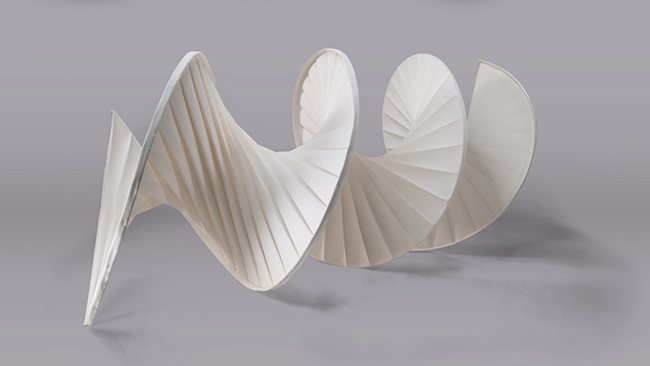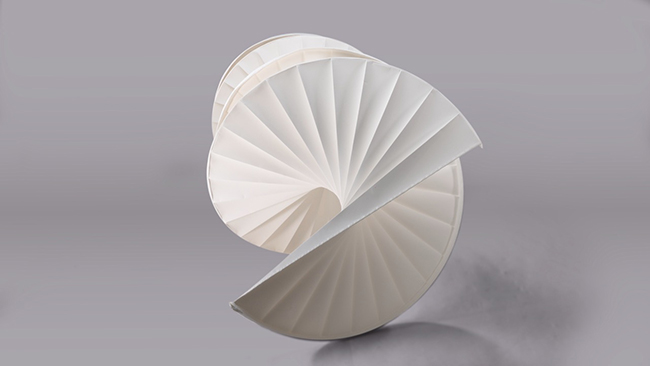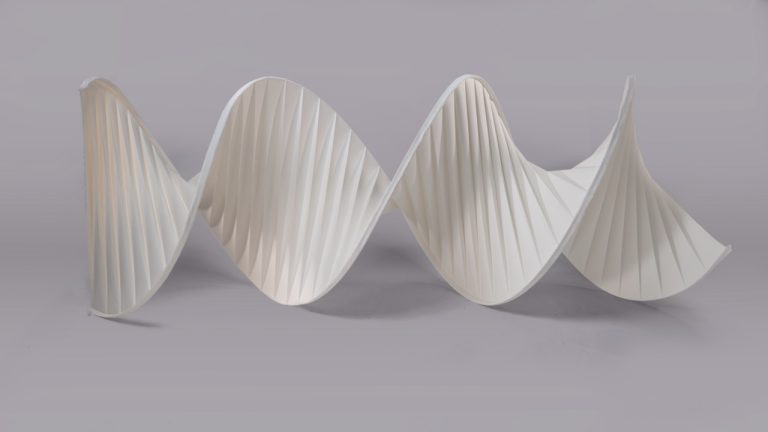Haeley Kyong’s work speaks to those who are drawn to the quiet power of simplicity. “I love creating artwork that captivates and inspires people’s minds,” she says, and this love is evident in every line and shape she creates. Her art is not about spectacle or complexity—it’s about clarity. She uses minimal forms, distilled to their essence, to bypass our internal filters and reach the emotions that live underneath thought. For Kyong, shapes and colors are not decorative but expressive; their relationships can hold the weight of both physical and nonphysical worlds. She believes the right combination can represent anything—a concept, a feeling, a presence. Deeply curious by nature, she draws inspiration from the patterns and rhythms of the natural world, translating them into forms that feel universal yet deeply personal. Her art asks us to pause and reconnect with what lies beneath the surface of perception.
A Circular Story Teller

At the center of Kyong’s recent work is a fascination with what makes us human—our structure, our essence, and the hidden code that binds us together. “I am fascinated by what makes us who we are,” she writes, “from the visible aspects to the invisible roots.” Her gaze reaches beyond the physical—beyond the outlines of faces or bodies—into the invisible strands of DNA, that quiet script we all carry. For Kyong, this unseen architecture is both humbling and beautiful. “We didn’t ask to be made this way,” she reflects. “We just inherited it. Without choice.”
Her piece A Circular Story Teller takes this contemplation and gives it form. Created on a single piece of Arches watercolor paper—forty-two inches by one hundred ninety-two inches—it is both vast and intimate. The paper is folded by hand, using traditional techniques, into a continuous structure that echoes the double helix. The result is less a flat image than a tactile rhythm of folds and shadows, as if the paper itself were breathing. Every crease becomes a moment of replication, a gesture toward the act of life repeating itself.
Working on this scale, Kyong transforms paper into something architectural. The surface becomes terrain; its structure embodies the very thing it represents. The folded paper twists and turns, much like the invisible strands of DNA it references. It’s an act of reverence—for the complexity of existence and for the simple, physical act of making. The folds are deliberate, but what they hold between them is mystery.
Kyong’s interest in DNA is not purely biological. It’s symbolic—a metaphor for inheritance, memory, and creation. DNA, for her, is both the story we’re given and the story we continue to tell. It’s the connection between what came before us and what follows after. The title A Circular Story Teller suggests continuity, a cycle that never truly ends. The form is circular because life is circular: replication, mutation, adaptation, and return.
Her decision to render this concept in watercolor paper instead of digital or sculptural materials gives the work a quiet humility. Watercolor paper absorbs light differently—it holds traces of the artist’s hand. The slight imperfections, the tension of the folds, the fragile texture—these all contribute to its sense of human touch. While DNA may be the code of life, Kyong’s folded paper becomes the code of care, an act of patience and physical engagement.

There’s something meditative about the process. Folding such an enormous sheet by hand is not a quick gesture but a slow commitment. It mirrors the replication of DNA, which happens constantly but invisibly. Through repetition and precision, Kyong makes visible the unseen. The scale of the work demands presence, yet its surface invites intimacy. Viewers often find themselves leaning closer, tracing the paths of the folds, following their curves as if reading a map without words.
In a way, A Circular Story Teller is both sculpture and drawing—both science and spirit. It reflects Kyong’s belief that art can bridge the rational and the emotional. Her use of geometry isn’t sterile; it’s alive, sensitive, and aware of the fragile balance between order and chaos. The folds and shadows become a metaphor for duality: visibility and invisibility, control and surrender, chance and design.
Kyong’s curiosity about our origins is not purely analytical—it’s existential. By turning the invisible into something tangible, she invites viewers to see their own reflection in this universal structure. We are, as she reminds us, shaped by forces we did not choose, bound by patterns we can’t fully see. Yet, within those patterns, there is beauty—endless, replicating beauty.
Through A Circular Story Teller, Haeley Kyong brings the microscopic into view, showing that art, like DNA, is an act of creation and continuation. Each fold is a sentence, each shadow a pause. Together, they tell a story that began long before us and will continue long after—a circular story, still unfolding.

